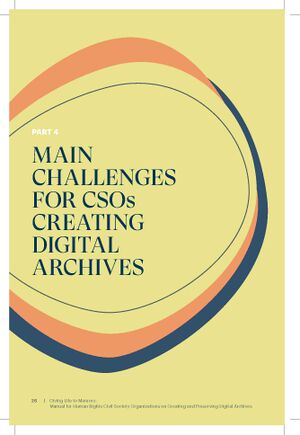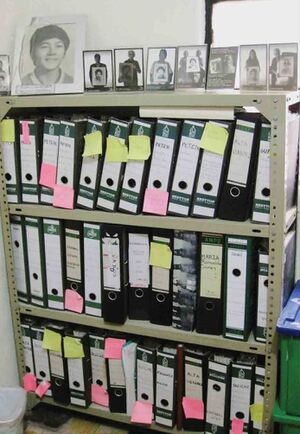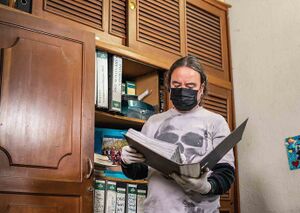Main challenges for CSOs creating digital archives: Difference between revisions
No edit summary |
(Marked this version for translation) |
||
| (2 intermediate revisions by 2 users not shown) | |||
| Line 1: | Line 1: | ||
<languages/> | <languages/> | ||
[[File:<translate>Main Challenges.jpg</translate>|thumb|<translate><!--T: | [[File:<translate><!--T:23--> Main Challenges.jpg</translate>|thumb|<translate><!--T:24--> 435x435px</translate>]] | ||
<translate> | <translate> | ||
Latest revision as of 12:06, 9 March 2024

The trouble with CSOs building digital archives is they never expected to become holders of archives.
CSOs usually have neither the resources, capacities, or expertise needed to create digital archives. Yet, the value of the material they have gathered and the need to preserve and leverage it is so high that organizations often have no choice but to take on this unexpected role of digital archivists.
For many CSOs, this can be a challenging and trying experience, as digital archiving is a complex and demanding function that requires significant human, financial, technological, and time resources—something CSOs typically do not have in abundance. Members of CSOs in such a position often speak of utter frustration and the feeling of being overwhelmed with the number and complexity of requirements involved with building a proper digital archive without having the appropriate means to address them.
The key challenge in this phase, as well as in the entire process of digital archiving, is to persist despite obstacles, not to give up, and patiently find a way to deal with the many difficulties that will inevitably come. The holy grail of preserving and leveraging invaluable, painstakingly gathered material that would otherwise be lost must certainly outweigh the task's difficulty.
Many inspiring stories of CSOs faced seemingly insurmountable challenges yet managed to overcome or find their way around them and eventually build successful digital archives.
The initial challenges an organization faces will likely be internal and related to the organization itself and its functioning. This includes the frequent lack of capacities needed for developing a digital archive—including expertise in digital archiving, human resources, financial means, necessary equipment, infrastructure, and space. However, further difficulties also often occur later in developing a digital archive.
Concerning finances, the difficulties often involve a lack of donor interest to support the long and resource-demanding process of building a digital archive. Moreover, building digital archives can involve unexpected costs and slower-than-expected progress, making raising the necessary funds even more difficult.

Handling human resource demands is equally challenging for an organization as building a digital archive. First, there is a need to significantly increase the number of staff, as digital archiving—especially in its early phases—requires a substantial workforce. This means an organization needs to quickly adapt to its new size, which can be difficult if the increase is substantial. Further, this often brings along a high fluctuation of archival staff with specific, sometimes unique knowledge of the archives, which creates two types of difficulties: it can lead to loss of institutional knowledge, and it creates an additional burden in terms of the need for constant training of new staff members. A significant challenge for most organizations is obtaining and keeping staff with the necessary expertise—in the archival or technical domain—which is needed throughout the process of building and developing a digital archive.
In cases where building a digital archive involves digitization of collections of physical materials, additional challenges are involved. Beyond obtaining the necessary equipment, software, and other technical solutions, as well as the necessary human resources, an organization must address the long-term preservation and storage of the original physical materials, which can require further resources, time, and expertise.
The quick pace of technological development and the stream of ever-new solutions in digital archiving present another challenge for CSOs. It can become difficult for an organization to follow the latest trends and solutions, obtain them, and train its staff to use and implement them. However, changes and updates are sometimes necessary as formats and technologies become obsolete. These can be incredibly challenging for CSOs developing their digital archives, as migration of archival data or transition to new software or hardware requires specific and extensive financial resources, time, workforce, and expertise. Many organizations also report that their country's lack of adequate internet infrastructure—primarily a stable internet broadband connection—creates significant challenges for developing their digital archives.
Another frequent concern for CSOs concerning digital archiving is the security and safety of the digital archival material. This relates to physical and cyber threats to data security and also involves the challenges of ensuring that sensitive and confidential data contained in the archive is not leaked to the public or an unauthorized person or organization.

Finally, CSOs building digital archives often report that an organization’s lack of adequate expertise is an important challenge in the process. Hence, organizations frequently need assistance in the form of external expertise for guidance or mentoring throughout the process. Simultaneously, CSOs must build their capacities and grow their internal expertise and institutional knowledge through practice and regular, targeted member training.
On top of this extensive set of internal, organization-related difficulties being insufficient, CSOs developing digital archives also regularly face several external challenges. These can include political pressure or security threats to the organization or its archives from people and organizations that do not want the archival material to be made public and accessible or used in legal processes. This is frequently the case for CSOs that build their digital archives during conflict or violent regime rule or in post-conflict and post-dictatorship periods in countries where elements of previous regimes—individuals or organizations—have retained substantial power and media and social control.
Often, the work of organizations documenting human rights abuses is condemned publicly by politicians and media that support them, with their digital archives proclaimed inaccurate or false. This can lead to a CSO’s negative public perception and alienation from its community, compromising staff well-being and security and creating practical difficulties for an archive’s development and daily operations.
* * *
After reading through this extensive thread of difficulties and obstacles involved with digital archiving for CSOs, you would be forgiven for asking why anyone would ever wish to bring upon their organization all these seemingly insurmountable challenges and how an organization could successfully navigate them.
The answer to the first part is simple but worth repeating: The difficulties in creating a digital archive require patience, perseverance, and readiness for the organization to take some blows, while progress should be measured in small steps. Yet, given that the goal of preserving and giving life to memory is so important and valuable, that trade-off is clear: This seriously challenging process of digital archiving is well worth taking for any CSO with a valuable archive to preserve.
The answer to the second part of the question is contained in the following chapters, which address the various challenges CSOs encounter in digital archiving. The core purpose of this manual is, as mentioned, to assist organizations in addressing these challenges—which are discussed throughout this manual in the context of the specific stages of digital archiving to which they are related—in their daily work with digital archives.